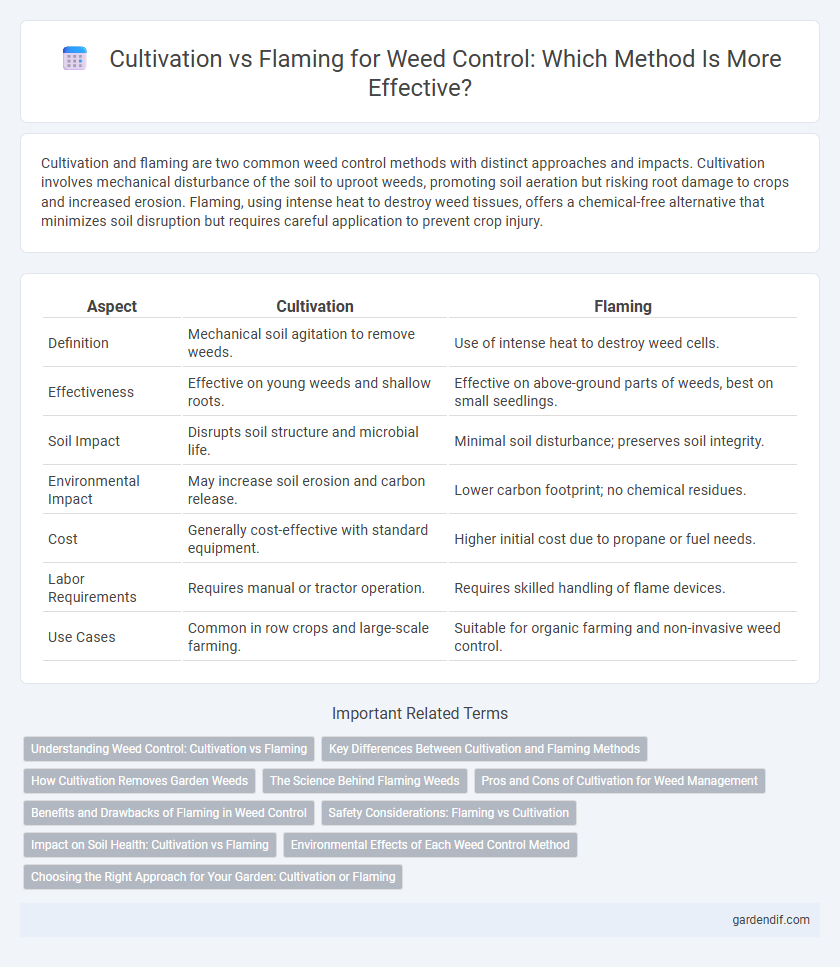
Cultivation vs flaming Illustration
Cultivation and flaming are two common weed control methods with distinct approaches and impacts. Cultivation involves mechanical disturbance of the soil to uproot weeds, promoting soil aeration but risking root damage to crops and increased erosion. Flaming, using intense heat to destroy weed tissues, offers a chemical-free alternative that minimizes soil disruption but requires careful application to prevent crop injury.
Table of Comparison
| Aspect | Cultivation | Flaming |
|---|---|---|
| Definition | Mechanical soil agitation to remove weeds. | Use of intense heat to destroy weed cells. |
| Effectiveness | Effective on young weeds and shallow roots. | Effective on above-ground parts of weeds, best on small seedlings. |
| Soil Impact | Disrupts soil structure and microbial life. | Minimal soil disturbance; preserves soil integrity. |
| Environmental Impact | May increase soil erosion and carbon release. | Lower carbon footprint; no chemical residues. |
| Cost | Generally cost-effective with standard equipment. | Higher initial cost due to propane or fuel needs. |
| Labor Requirements | Requires manual or tractor operation. | Requires skilled handling of flame devices. |
| Use Cases | Common in row crops and large-scale farming. | Suitable for organic farming and non-invasive weed control. |
Understanding Weed Control: Cultivation vs Flaming
Weed control methods like cultivation and flaming target weed suppression through mechanical and thermal means respectively, significantly impacting crop health and yield. Cultivation disturbs the soil to uproot weeds, promoting better aeration and growth conditions for crops, while flaming uses intense heat to destroy weed cells without soil disruption. Prioritizing these techniques depends on crop type, soil condition, and environmental impact, with cultivation preferred for deep-rooted weeds and flaming advantageous for organic farming systems seeking chemical-free control.
Key Differences Between Cultivation and Flaming Methods
Cultivation involves mechanical soil disturbance to promote weed control, enhancing aeration and nutrient mixing, while flaming uses intense heat to kill weeds without soil disruption. Cultivation is effective for managing larger weed populations and can improve soil structure, whereas flaming targets young seedlings and organic residues without affecting soil integrity. The choice between cultivation and flaming depends on crop sensitivity, soil conditions, and long-term weed management goals.
How Cultivation Removes Garden Weeds
Cultivation removes garden weeds by physically disturbing the soil to uproot and bury weed seedlings, preventing their growth and reproduction. This method targets the root systems, ensuring that weeds cannot re-establish, which reduces overall weed population in the garden. Consistent cultivation disrupts weed life cycles and promotes healthier crop growth by minimizing competition for nutrients, water, and sunlight.
The Science Behind Flaming Weeds
Flaming weed control relies on thermal shock to disrupt the plant's cell structure, causing rapid dehydration and cell rupture without soil disturbance. Cultivation physically uproots or buries weeds, often promoting further growth by exposing dormant seeds to light and improving soil aeration. Scientific studies demonstrate that flaming targets above-ground weed tissues, effectively controlling young seedlings while minimizing soil ecosystem impact compared to traditional tillage methods.
Pros and Cons of Cultivation for Weed Management
Cultivation for weed management promotes soil aeration and disrupts weed growth by uprooting seedlings, which enhances crop health and yield. It can, however, lead to soil erosion, moisture loss, and increased labor costs compared to chemical or flaming methods. Despite these drawbacks, cultivation remains an effective method for controlling perennial weeds and integrating into organic farming systems.
Benefits and Drawbacks of Flaming in Weed Control
Flaming as a weed control method offers the benefit of targeting weeds without chemical herbicides, reducing environmental pollution and chemical resistance. However, it poses drawbacks such as potential crop damage if applied too close and limited efficacy against deep-rooted perennial weeds. This technique is most effective in early growth stages, promoting weed suppression while preserving soil health.
Safety Considerations: Flaming vs Cultivation
Flaming offers a chemical-free weed control method that minimizes soil disturbance and reduces the risk of herbicide resistance, enhancing environmental safety. Cultivation involves mechanical soil disruption that can lead to erosion and damage beneficial soil organisms, posing ecological risks. Proper timing and technique in flaming are crucial to prevent fire hazards, while cultivation requires equipment safety precautions to avoid operator injury.
Impact on Soil Health: Cultivation vs Flaming
Cultivation disrupts soil structure, leading to increased erosion and loss of organic matter, which negatively affects soil health over time. Flaming, by contrast, minimizes soil disturbance, preserving microbial communities and maintaining soil stability. Choosing flaming over cultivation can enhance long-term soil fertility and support sustainable weed management practices.
Environmental Effects of Each Weed Control Method
Cultivation disrupts weed growth by physically turning the soil, which can increase soil erosion and reduce moisture retention, negatively impacting local ecosystems. Flaming uses intense heat to kill weeds without disturbing the soil structure, thereby preserving soil biodiversity and reducing carbon release. Comparing environmental effects, flaming presents a lower risk of habitat degradation and maintains soil health more effectively than cultivation.
Choosing the Right Approach for Your Garden: Cultivation or Flaming
Cultivation and flaming are two effective weed control methods, each suited to different garden needs and plant types. Cultivation disturbs the soil, uprooting weeds mechanically, which is ideal for larger areas with robust plants, while flaming uses intense heat to damage weed tissue without soil disruption, perfect for delicate plantings and organic gardens. Selecting the right approach depends on weed species, soil conditions, and crop sensitivity, ensuring optimal growth and minimizing chemical use.
Cultivation vs flaming Infographic

 gardendif.com
gardendif.com